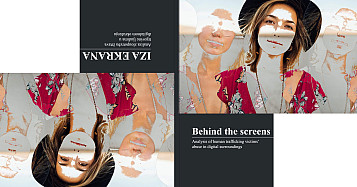Original post from Atina here
For organisation Atina, it is of utmost importance that the voices of girls and women with the experience of trafficking are heard. And not only heard but understood and appreciated as well. That is why we created this document Behind the screens: Analysis of human trafficking victims’ abuse in digital surroundings, which includes experiences of 178 girls and women who were using Atina’s support and protection programs in the period from 2015 until 2020.[1] Such a number of respondents in the field of human trafficking victims’ protection is an extremely important sample, and it should be noted that data collection process was marked by exceptional motivation of these girls and women to participate in it. It is also important to point out that this analysis was carried out during the pandemic, when a large part of global communication moved to the digital space, and the risks of violence and exploitation increased.
The results of this analysis confirm high prevalence of abuse in digital surroundings these girls and women have been exposed to prior, during and after the trafficking situation. Specifically, 42% of respondents survived some form of digital violence (such as cyberbullying, vengeful distribution of explicit/pornographic content, impersonation, etc.), while for 31% of them digital violence was directly related to the trafficking situation, both for the purpose of recruitment and exploitation. Of the total number of respondents, 65% were also exposed to digital threats, which were most often aimed at intimidation in order to change or withdraw a testimony or statement in criminal proceedings (a total of 59%). In addition to the high frequency of violence in a digital sphere, the analysis also shows that this specific type of violence has become an almost indispensable form of coercion used by perpetrators of violence and traffickers to blackmail, threaten, belittle the victims, unauthorizedly record, or distribute pornographic material including children. In this regard, the purpose of the analysis is to prevent digital abuse from becoming a «new normal» and a phenomenon to which the public, due to its frequency, becomes indifferent to, under the slogan – virtual is less real, and therefore less important.
The main pretension of this analysis, which Atina’s team considers to be introductory, and represents a current situation in practice, is that the fight against violence and abuse in digital surroundings in the context of human trafficking should become a priority on the agenda of all actors who are a part of official mechanism for support and protection of human trafficking victims in Serbia. The document itself is intended for interested and professional public, representatives of state institutions working in this field at the national and local level, as well as civil society organizations, private sector, media and the general public. And not only that, from Atina’s point of view it is necessary for this topic to finally take its own place in all the relevant national documents that will be created in the coming period, particularly in the future National Strategy for Combating Trafficking in Human Beings, and accompanying Action Plans, considering that this topic does not have such a place in the current strategy. It is also our wish for this analysis to serve as a basis for further, more extensive research on the topic of abuse in digital surroundings in the context of human trafficking in Serbia, and to shed a light on many of the concepts this paper has only touched on.
Bearing in mind that terminology is crucial in deliberating this sensitive topic, its development should correspond to the essence of phenomena being described, and emphasize the responsibility of perpetrators, i.e. those causing them. In this regard, it is important, both in our country and beyond, to invest particular efforts in development of terminology that accompanies this topic, and thus stop the use of archaic, inaccurate and incorrect terms that do not correspond to the essence of the phenomenon, such as "child prostitution and pornography”, considering that a child cannot voluntarily participate in such a thing, and that those cases are a matter of sexual exploitation and abuse of children, persons under 18 years of age; thus, in this particular case, it would be more correct to use the terms abuse of children in prostitution, and exploitation of children for pornographic purposes.
We believe that many of you will come across terms in this document that explain various phenomena related to abuses in digital surroundings you have not heard before. For this reason, slighter known forms of abuse in digital context, such as doxing (targeting), catfishing (luring) and others, are explained in detail hoping they will find use within professional and general public, and contribute to the identification, reporting and provision of adequate assistance and support to the victims. We hope that this analysis will encourage professionals to further reconsider their roles in the process of victims’ protection in the context of digital abuse, and that this topic will become an obligatory part of the approach to the phenomenon of gender-based violence.
Jelena Hrnjak, programme manager of the organisation Atina
In Belgrade, October 2020
[1] Organisation Atina has, since 2003, been implementing a program of long-term social inclusion of human trafficking victims, as well as victims of all forms of gender-based violence and exploitation, that is based on respect for human rights and conducted with full participation, consent, and cooperation of the beneficiaries.
![]() Behind the screens Analysis of human trafficking victims’ abuse in digital surroundings.pdf
Behind the screens Analysis of human trafficking victims’ abuse in digital surroundings.pdf
